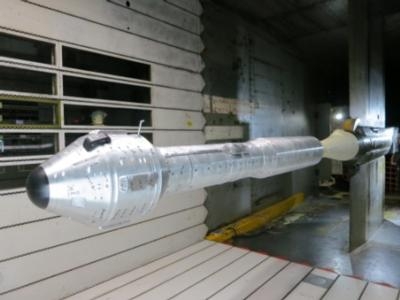Wed, Jun 05, 2013
Completes Wind Tunnel Testing Of CTS-100 Spacecraft, Atlas V Rocket
The Boeing Company of Houston, a NASA Commercial Crew Program (CCP) partner, recently performed wind tunnel testing of its CST-100 spacecraft and integrated launch vehicle, the United Launch Alliance (ULA) Atlas V rocket. The testing is part of NASA's Commercial Crew Integrated Capability (CCiCap) initiative, intended to make commercial human spaceflight services available for government and commercial customers.

Boeing and ULA also worked together to test a newly developed component of the Atlas V's Centaur upper stage. Boeing now has completed two of eight performance milestones under CCiCap and is on track to complete all 19 of its milestones around mid-2014. "The Centaur has a long and storied past of launching the agency's most successful spacecraft to other worlds," said Ed Mango, NASA's CCP manager at the agency's Kennedy Space Center in Florida. "Because it has never been used for human spaceflight before, these tests are critical to ensuring a smooth and safe performance for the crew members who will be riding atop the human-rated Atlas V."
The wind tunnel tests, which began in March and wrapped up in May at NASA's Ames Research Center in Moffett Field, CA, were the first interface tests of Boeing's spacecraft, launch vehicle adaptor and launch vehicle. A scale model of the integrated spacecraft and rocket was placed in Ames' 11-foot diameter transonic wind tunnel. The data gathered provides Boeing with critical information it needs to ensure its system is safe for launching crews to low-Earth orbit.
The Centaur liquid oxygen-feed duct line was tested in March in Murrieta, CA, to characterize how liquid oxygen moves from the stage's oxygen tank to its two engines where the propellant will be mixed with liquid hydrogen to create thrust. The Centaur, which takes over after the Atlas V first stage runs low on propellants, will push the spacecraft to its intended orbit. The Centaur has an extensive and successful history of delivering spacecraft to their destinations, including carrying NASA's Curiosity science rover to Mars. "The CST-100 and Atlas V, connected with the launch vehicle adaptor, performed exactly as expected and confirmed our expectations of how they will perform together in flight," said John Mulholland, Boeing vice president and program manager for Commercial Programs.
Boeing is one of three U.S. companies NASA is working with during CCiCap to set the stage for a crewed orbital demonstration mission around the middle of the decade.
(Image provided by Boeing)
More News
He Attempted To Restart The Engine Three Times. On The Third Restart Attempt, He Noticed That Flames Were Coming Out From The Right Wing Near The Fuel Cap Analysis: The pilot repor>[...]
Make Sure You NEVER Miss A New Story From Aero-News Network Do you ever feel like you never see posts from a certain person or page on Facebook or Instagram? Here’s how you c>[...]
From 2009 (YouTube Edition): Leading Air Show Performers Give Their Best Advice for Newcomers On December 6th through December 9th, the Paris Las Vegas Hotel hosted over 1,500 air >[...]
Aero Linx: NASA ASRS ASRS captures confidential reports, analyzes the resulting aviation safety data, and disseminates vital information to the aviation community. The ASRS is an i>[...]
“For our inaugural Pylon Racing Seminar in Roswell, we were thrilled to certify 60 pilots across our six closed-course pylon race classes. Not only did this year’s PRS >[...]
 NTSB Final Report: Rutan Long-EZ
NTSB Final Report: Rutan Long-EZ ANN FAQ: Turn On Post Notifications
ANN FAQ: Turn On Post Notifications Classic Aero-TV: ICAS Perspectives - Advice for New Air Show Performers
Classic Aero-TV: ICAS Perspectives - Advice for New Air Show Performers ANN's Daily Aero-Linx (06.28.25)
ANN's Daily Aero-Linx (06.28.25) Aero-News: Quote of the Day (06.28.25)
Aero-News: Quote of the Day (06.28.25)



